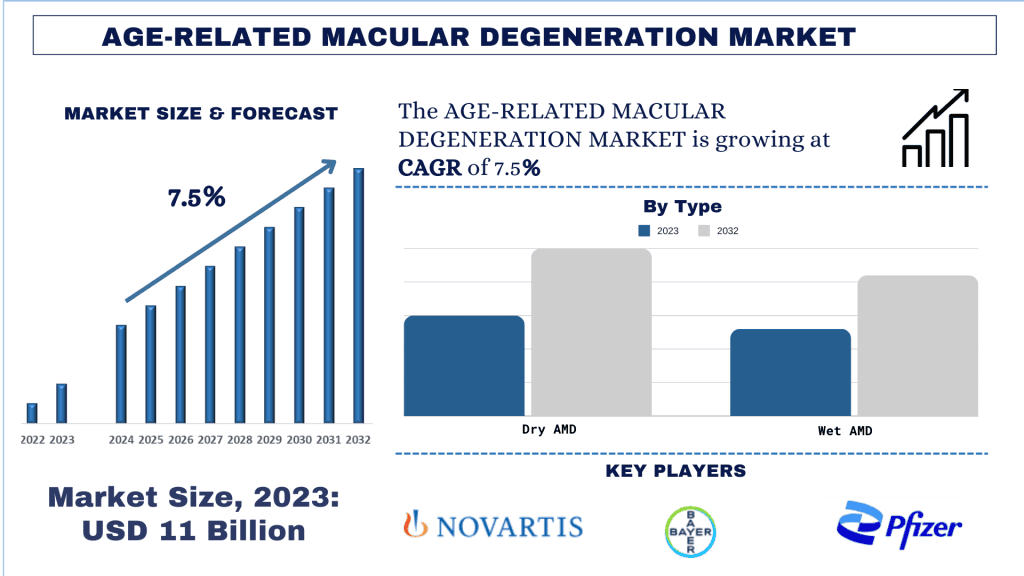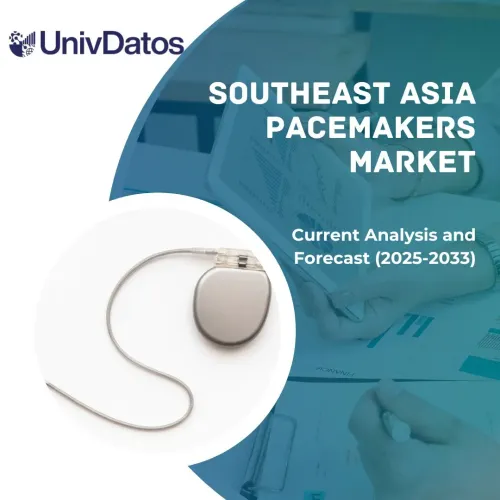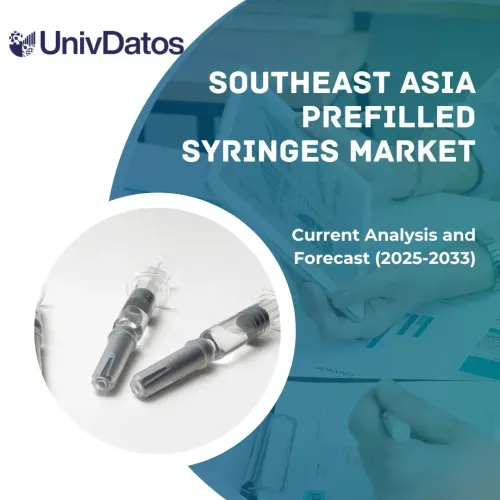- Home
- About Us
- Industry
- Services
- Reading
- Contact Us
Age-related Macular Degeneration Market: Current Analysis and Forecast (2024-2032)
Emphasis on Type (Dry AMD and Wet AMD); Product (Eylea, Lucentis, Beovu, and Others), Distribution Channel (Retail Pharmacy, Hospital Pharmacy, and Online Pharmacy); and Region/Country
Age-related Macular Degeneration Market Size & Forecast
The Age-related Macular Degeneration market was valued at approximately USD 11 Billion in 2023 and is expected to grow at a strong CAGR of around 7.5% during the forecast period (2024-2032) owing to the rising cases of AMD.
Age-related Macular Degeneration Market Analysis
Age-related macular degeneration (AMD) is a leading cause of vision loss among older adults, characterized by the deterioration of the macula, the central part of the retina responsible for sharp vision. The market for AMD treatments has been expanding due to the increasing prevalence of the condition, driven by an aging global population and new product launch. This analysis explores the primary drivers fueling the growth of the AMD market.
For instance, according to the American Academy of Ophthalmology (AAO), as of 2021, approximately 11 million people in the United States are affected by some form of age-related macular degeneration. The prevalence of AMD is expected to double by 2050 due to the aging population, highlighting the urgent need for effective treatment options and driving market expansion.
For Instance, in May 2024, FDA approved Yesafili (aflibercept-jbvf) and Opuviz (aflibercept-yszy) as biosimilars that can be used in place of Eylea (aflibercept) to treat macular degeneration and other eye problems.
For instance, in Feb 2023, Pegcetacoplan, also marketed as Syfovre, is the first medication to treat dry age-related macular degeneration (AMD) to be licensed for use in the United States by the Food and Drug Administration (FDA).
Age-related Macular Degeneration Market Trends
This section discusses the key market trends that are influencing the various segments of the Age-related Macular Degeneration Market as identified by our team of research experts.
Innovative Treatment Approaches
Recent developments in gene therapy are showing promise for treating AMD. These therapies aim to correct genetic defects that cause AMD or provide protective factors directly to retinal cells. Companies are actively researching gene-based treatments to offer more durable solutions compared to conventional therapies. Another groundbreaking trend is the exploration of stem cell therapy for AMD. These treatments involve replacing damaged retinal cells with healthy ones derived from stem cells, potentially restoring vision in patients with advanced AMD.
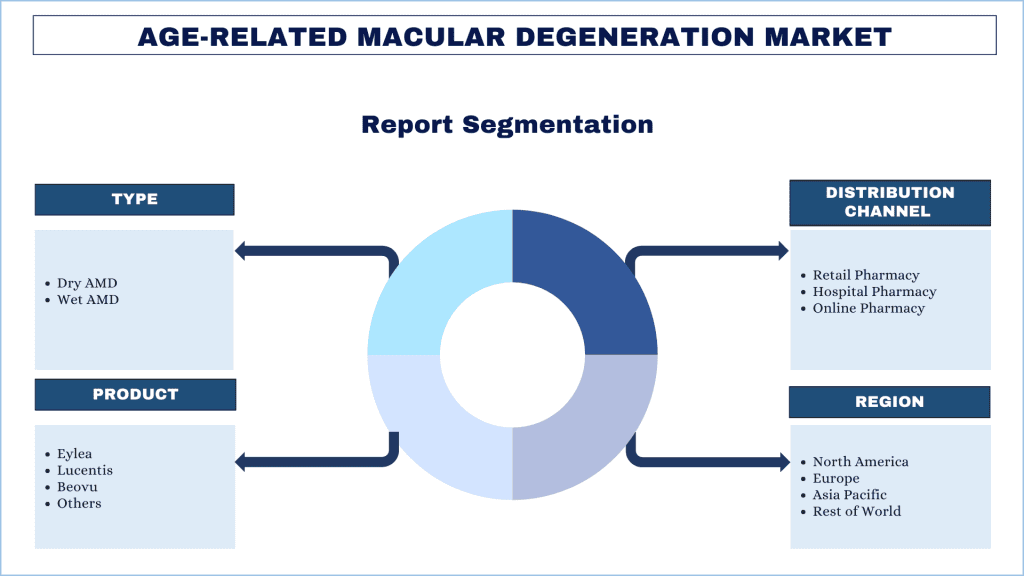
North America is Expected to Grow with Significant CAGR During Forecast Period
The Age-related Macular Degeneration market in North America has experienced significant growth in recent years, driven by various factors. North America, particularly the U.S., represents one of the largest markets for Age-related Macular Degeneration globally. One of the primary drivers of the Age-related Macular Degeneration market in North America is the increasing cases of AMD. For instance, approximately 15 million people in North America have AMD, according to the American Academy of Ophthalmology.
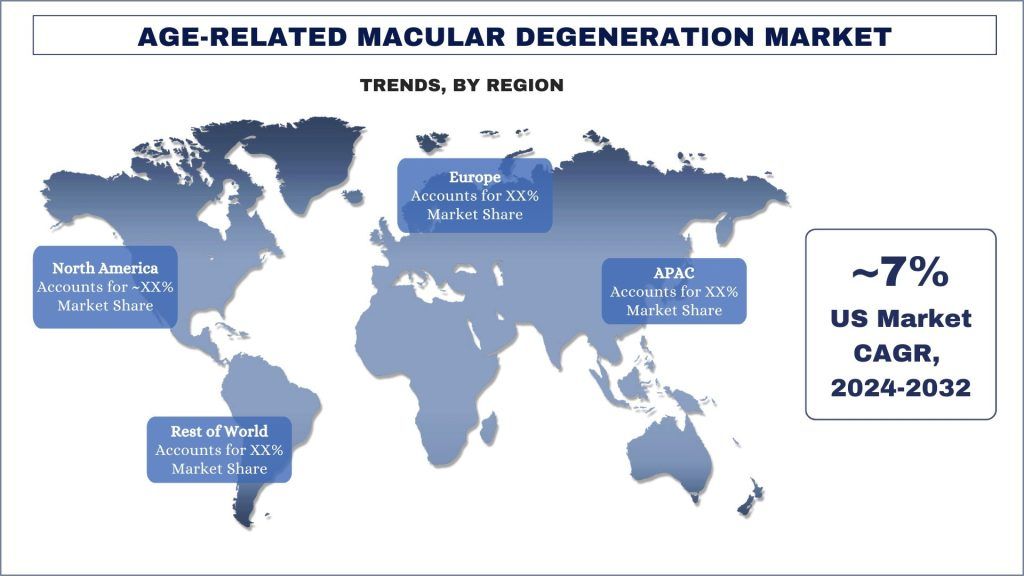
Age-related Macular Degeneration Industry Overview
The Age-related Macular Degeneration market is competitive, with the presence of several global and international market players. The key players are adopting different growth strategies to enhance their market presence, such as partnerships, agreements, collaborations, new product launches, geographical expansions, and mergers and acquisitions. Some of the major players operating in the market are Novartis AG, Bayer AG, Pfizer Inc., Bausch Health Companies Inc., Amgen Inc., Regeneron Pharmaceuticals Inc., Biogen, F. HoffmannLa Roche Ltd, Samsung Bioepis, and Outlook Therapeutics, Inc.
Age-related Macular Degeneration Market Report Coverage
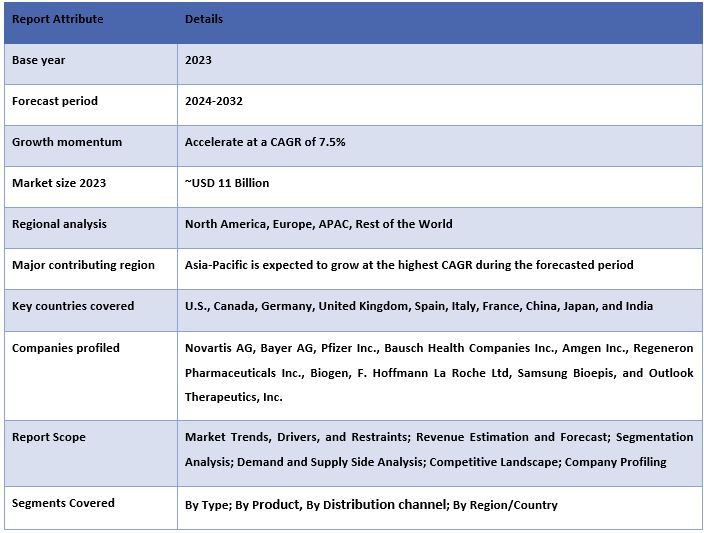
Reasons to buy this report:
- The study includes market sizing and forecasting analysis validated by authenticated key industry experts.
- The report presents a quick review of overall industry performance at one glance.
- The report covers an in-depth analysis of prominent industry peers with a primary focus on key business financials, product portfolios, expansion strategies, and recent developments.
- Detailed examination of drivers, restraints, key trends, and opportunities prevailing in the industry.
- The study comprehensively covers the market across different segments.
- Deep dive regional level analysis of the industry.
Customization Options:
The global Age-related Macular Degeneration market can further be customized as per the requirement or any other market segment. Besides this, UMI understands that you may have your own business needs, hence feel free to connect with us to get a report that completely suits your requirements.
Table of Content
Research Methodology for the Age-related Macular Degeneration Market Analysis (2024-2032)
Analyzing the historical market, estimating the current market, and forecasting the future market of the global Age-related Macular Degeneration market were the three major steps undertaken to create and analyze the adoption of Age-related Macular Degeneration in major regions globally. Exhaustive secondary research was conducted to collect the historical market numbers and estimate the current market size. Secondly, to validate these insights, numerous findings and assumptions were taken into consideration. Moreover, exhaustive primary interviews were also conducted, with industry experts across the value chain of the global Age-related Macular Degeneration market. Post assumption and validation of market numbers through primary interviews, we employed a top-down/bottom-up approach to forecasting the complete market size. Thereafter, market breakdown and data triangulation methods were adopted to estimate and analyze the market size of segments and sub-segments of the industry pertains to. Detailed methodology is explained below:
Analysis of Historical Market Size
Step 1: In-Depth Study of Secondary Sources:
A detailed secondary study was conducted to obtain the historical market size of the Age-related Macular Degeneration market through company internal sources such as annual reports & financial statements, performance presentations, press releases, etc., and external sources including journals, news & articles, government publications, competitor publications, sector reports, third-party database, and other credible publications.
Step 2: Market Segmentation:
After obtaining the historical market size of the Age-related Macular Degeneration market, we conducted a detailed secondary analysis to gather historical market insights and share for different segments & sub-segments for major regions. Major segments are included in the report as type, Product, distribution channel and regions. Further country-level analyses were conducted to evaluate the overall adoption of testing models in that region.
Step 3: Factor Analysis:
After acquiring the historical market size of different segments and sub-segments, we conducted a detailed factor analysis to estimate the current market size of the Age-related Macular Degeneration market. Further, we conducted factor analysis using dependent and independent variables such as type, Product, distribution channel and regions of the Age-related Macular Degeneration market. A thorough analysis was conducted for demand and supply-side scenarios considering top partnerships, mergers and acquisitions, business expansion, and product launches in the Age-related Macular Degeneration market sector across the globe.
Current Market Size Estimate & Forecast
Current Market Sizing: Based on actionable insights from the above 3 steps, we arrived at the current market size, key players in the global Age-related Macular Degeneration market, and market shares of the segments. All the required percentage shares split, and market breakdowns were determined using the above-mentioned secondary approach and were verified through primary interviews.
Estimation & Forecasting: For market estimation and forecast, weights were assigned to different factors including drivers & trends, restraints, and opportunities available for the stakeholders. After analyzing these factors, relevant forecasting techniques i.e., the top-down/bottom-up approach were applied to arrive at the market forecast for 2032 for different segments and sub-segments across the major markets globally. The research methodology adopted to estimate the market size encompasses:
- The industry’s market size, in terms of revenue (USD) and the adoption rate of the Age-related Macular Degeneration market across the major markets domestically
- All percentage shares, splits, and breakdowns of market segments and sub-segments
- Key players in the global Age-related Macular Degeneration market in terms of products offered. Also, the growth strategies adopted by these players to compete in the fast-growing market.
Market Size and Share Validation
Primary Research: In-depth interviews were conducted with the Key Opinion Leaders (KOLs) including Top Level Executives (CXO/VPs, Sales Head, Marketing Head, Operational Head, Regional Head, Country Head, etc.) across major regions. Primary research findings were then summarized, and statistical analysis was performed to prove the stated hypothesis. Inputs from primary research were consolidated with secondary findings, hence turning information into actionable insights.
Split of Primary Participants in Different Regions
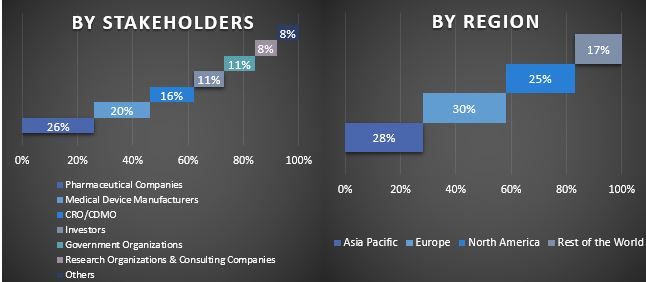
Market Engineering
The data triangulation technique was employed to complete the overall market estimation and to arrive at precise statistical numbers for each segment and sub-segment of the global Age-related Macular Degeneration market. Data was split into several segments & sub-segments post studying various parameters and trends in the areas of the Type, Product, distribution channel and regions in the global Age-related Macular Degeneration market.
The main objective of the Global Age-related Macular Degeneration Market Study
The current & future market trends of the global Age-related Macular Degeneration market were pinpointed in the study. Investors can gain strategic insights to base their discretion for investments on the qualitative and quantitative analysis performed in the study. Current and future market trends determined the overall attractiveness of the market at a regional level, providing a platform for the industrial participant to exploit the untapped market to benefit from a first-mover advantage. Other quantitative goals of the studies include:
- Analyze the current and forecast market size of the Age-related Macular Degeneration market in terms of value (USD). Also, analyze the current and forecast market size of different segments and sub-segments.
- Segments in the study include areas of the Type, Product, distribution channel and regions.
- Define and analysis of the regulatory framework for the Age-related Macular Degeneration
- Analyze the value chain involved with the presence of various intermediaries, along with analyzing customer and competitor behaviors of the industry.
- Analyze the current and forecast market size of the Age-related Macular Degeneration market for the major region.
- Major countries of regions studied in the report include Asia Pacific, Europe, North America, and the Rest of the World
- Company profiles of the Age-related Macular Degeneration market and the growth strategies adopted by the market players to sustain in the fast-growing market.
- Deep dive regional level analysis of the industry.
Frequently Asked Questions FAQs
Q1: What is the Age-related Macular Degeneration market's current market size and growth potential?
Q2: What are the driving factors for the growth of the Age-related Macular Degeneration market?
Q3: Which segment has the largest share of the Age-related Macular Degeneration market by type?
Q4: What are the emerging technologies and trends in the Age-related Macular Degeneration market?
Q5: Which region will dominate the Age-related Macular Degeneration market?
Related Reports
Customers who bought this item also bought

